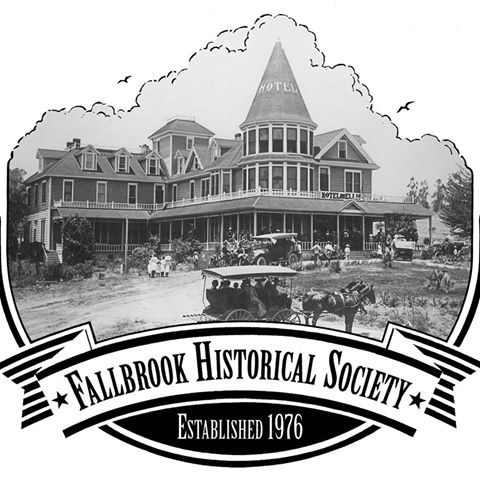Frank Capra was a Fallbrook olive oil producer who also made famous movies in Hollywood.
Immigration and Hollywood Success: Frank Capra, a future Fallbrook resident, was born May, 18, 1897 in a small village of Sicily.
He was the youngest of 7 children.
Capra’s parents brought the family to America in 1903, first by ship to New York. They traveled in steerage and were processed at Ellis Island. The family then traveled by train to Los Angeles to join with a relative. Young Frank grew up in a working-class neighborhood of East L.A, which Capra described in his biography as an Italian ghetto. After briefly serving in the U.S. Army before the end of WWI, Capra found work in L.A. writing for silent films. Working his way up in the film industry, Capra achieved spectacular fame as the Director of;
It Happened One Night (1935) Academy Awards for Best Movie and Best Director
Mr. Deeds Goes to Town (1936) Academy Award for Best Director
You Can’t Take it with You (1938) Academy Award for Best Director
Mr. Smith Goes to Washington (1939) nominated for Best Director
It’s a Wonderful Life (1946) nominated for five Academy Awards, but the movie did not initially receive much acclaim, although that would change many years later.
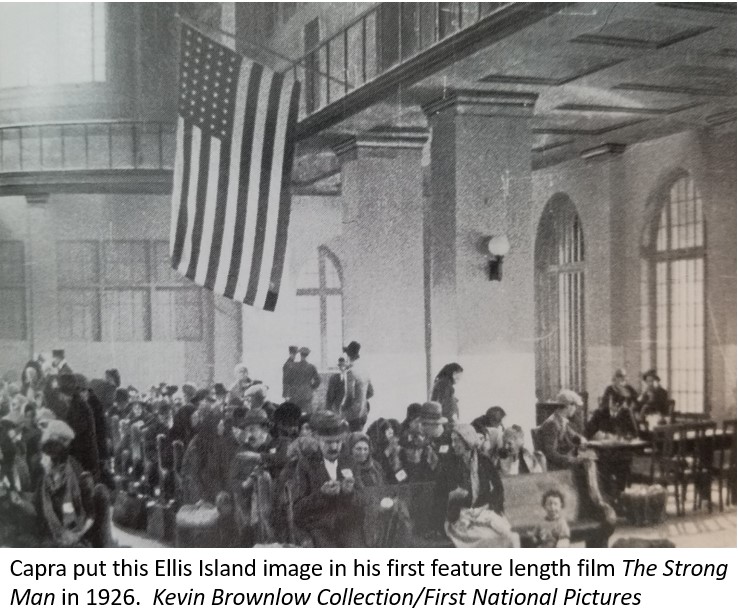
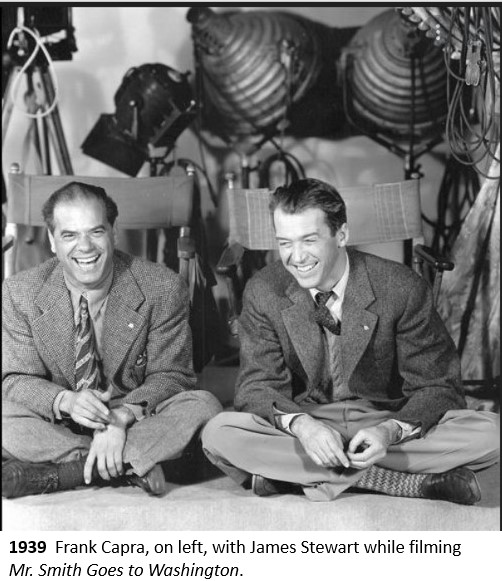
Red Mountain: In 1939 while filming Mr. Smith Goes to Washington, Capra was planning to end his contract with Columbia Pictures. Frustrations with the Hollywood studios made Capra start contemplating his future retirement. Considering where he might retire to, made him think about fulfilling his father’s failed dream to own an olive or citrus ranch. Frank Capra asked his father-in-law Myron “Pop” Warner to scout property for him. Warner found the historic 536-acre Red Mountain Ranch in Fallbrook for sale. The land was mostly idle, but it contained 105 acres of olive trees, an olive press, citrus groves, and a new half-million-gallon reservoir. Orchards and intricate gardens surrounded the property. Busy with filming Mr. Smith, Frank Capra bought the place on Warner’s recommendation, sight unseen, for $70,000. Soon after, also on Warner’s recommendation, Capra bought an additional 520 acres of steep and rocky land surrounding Red Mountain for only $6,000. It seemed like a good long-term investment, and ultimately it was. Capra planted more acres of citrus plus 52 acres of avocados.
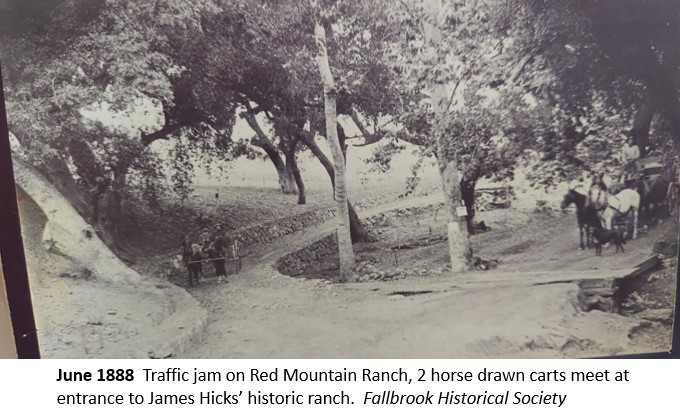
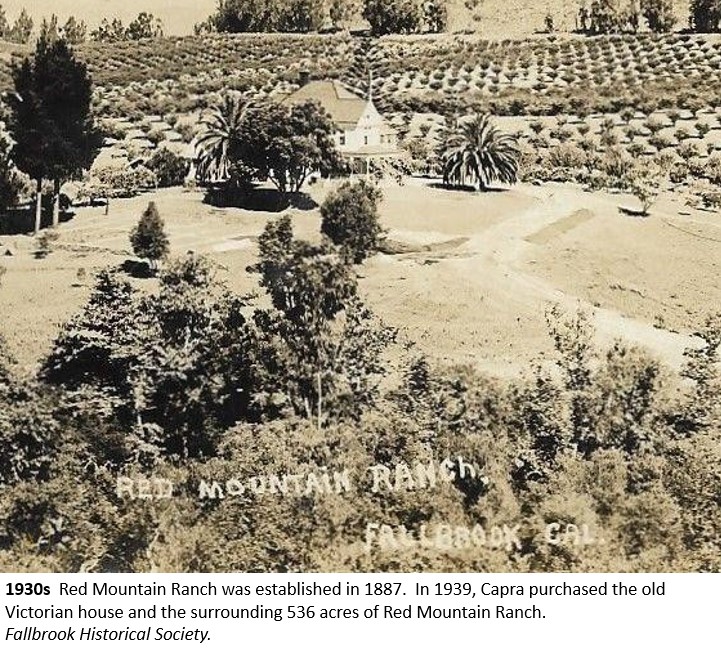
Capra Olive Oil: Pop Warner and his wife moved to Fallbrook and lived in a bungalow on Capra’s Red Mountain, to be the resident property manager for his son-in-law. After 10 years of neglect by previous owners, Capra and Warner rehabilitated the olive orchards and put the olive press back into production. When World War Two shut down oil exports from Southern Europe. Capra started an olive oil mail order business. Them bottles were labeled Fallbrook Olive Oil “Produced by Frank Capra”. Warner managed the business.
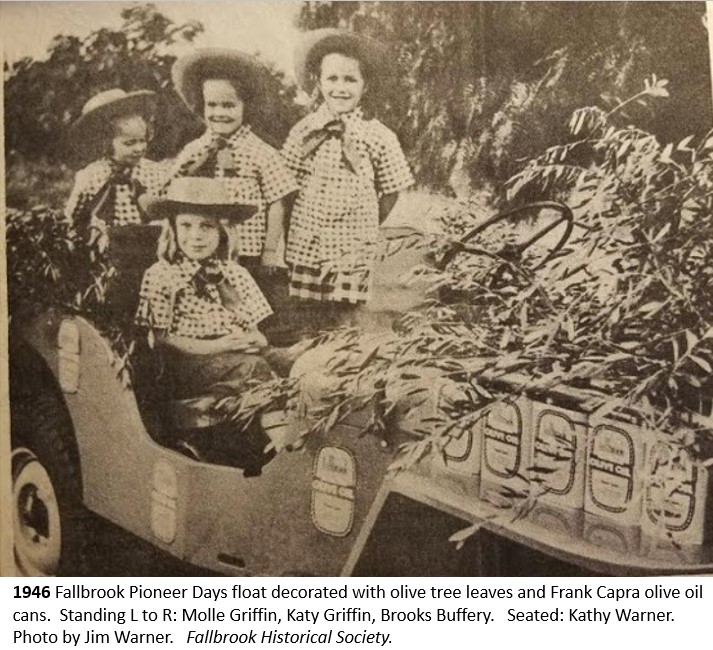
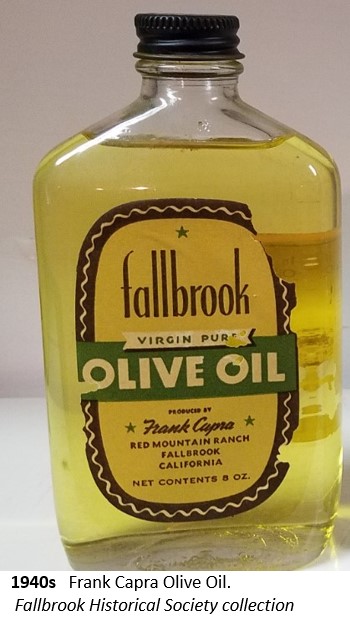
Why We Fight: A few days following the attack on Pearl Harbor in 1941, Capra resigned his positions in Hollywood to accept a commission in the U.S. Army. By resigning from the studio for a modest Army salary, Capra gave up an eminent and lucrative position in the film industry that he would never recapture. He was assigned by the Pentagon to make morale documentaries, including the Prelude to War and the Why We Fight films for the Pentagon. These documentaries were shown to soldiers and to the public across the country. Capra often worked out of an available Fox studio in Hollywood, where he had all the equipment he needed. When he was in California he would sleep at his Brentwood home. His wife Lucille and the 4 children spent most of the war at Red Mountain in Fallbrook. Lucille volunteered at the Naval hospital on nearby Camp Pendleton. Capra was promoted to be a full colonel in the U.S. Army by the end of the war in 1945.
Capra’s mail order olive oil business gradually came to an end after the war ended, when Italy, Greece and other Mediterranean countries began exporting their olive oil again. Frank Capra began working in Hollywood making a new movie with his friend and fellow veteran, Jimmy Stewart.
It’s a Wonderful Life, released in 1946, has several Fallbrook names in the movie. The characters are not the same at all, but it seems the movie borrowed names of several well-known Fallbrook people; Bailey, Potter, Reinman, Clarence, and Bert. People that Capra had likely become acquainted with in 1940s Fallbrook.
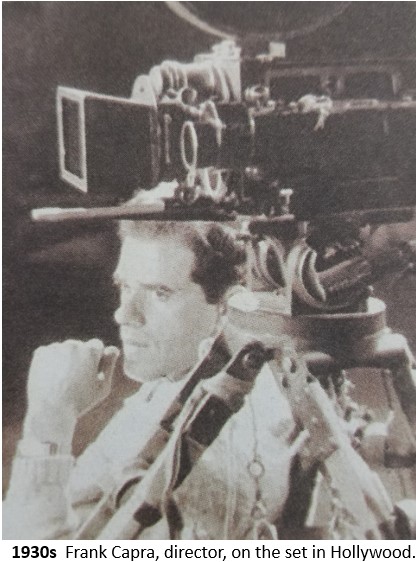
The Fallbrook Story: Red Mountain Ranch and other Fallbrook farmers had been pumping water from the Santa Margarita River for decades. That was sufficient for growing olives, but not enough for large scale production of citrus and avocados. Since the 1920s, ranchers and the Fallbrook Public Utility District (FPUD) were considering building a dam along the Santa Margarita River. A renewed effort to push for the dam in the late 1940s prompted the U.S. government to file a lawsuit in 1951 against FPUD for “unlawful interference” with Camp Pendelton water. In addition to FPUD, the lawsuit named Frank Capra, along with many other property owners. Like lots of Rainbow and Fallbrook farmers, Red Mountain Ranch had water rights to the Santa Margarita River going back to 1880s, long before the Marines built Camp Pendelton in 1942.
Driven to action by the lawsuit, in 1952 Capra agreed to make a propaganda film for the Chamber of Commerce called The Fallbrook Story. Financed and written by the Los Angeles Times, Capra kept his name from appearing anywhere on the movie, presumably because it was not up to his Oscar winning standards.
Although Capra had no interest in politics, he allowed himself to be persuaded to be appointed to the Board of the Fallbrook Public Utility District in December, 1953. Having desired a peaceful ranch lifestyle, Capra was stunned to immediately find himself stuck in the middle of red-hot water controversies. He had conflicts of interest on both sides. His ranch pumped Santa Margarita water to his Red Mountain reservoir, he was named in the government lawsuit, plus FPUD, had taken some of his land and his neighbor’s land using eminent domain to build the disputed dam.
Unhappy with finding himself involved in politics and controversy, Capra began spending more time back in Hollywood making new movies. Capra resigned from FPUD in June, 1955 when he suddenly decided to temporarily move out of the district while he tore down his 1887 Victorian home and build a new modern ranch house. But Capra did not stay away long. He liked Fallbrook and living on his ranch. He had a lot of friends in Fallbrook.
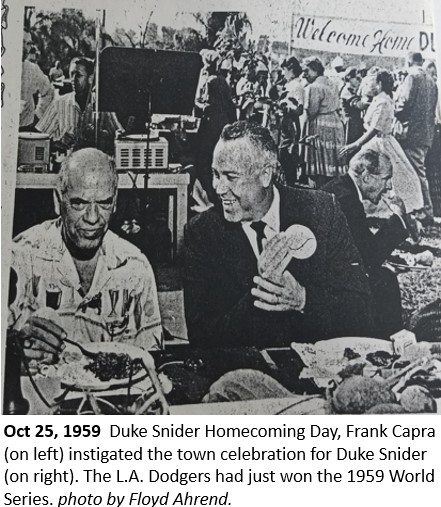
When the Los Angeles Dodgers won the World Championship in October 1959, Capra helped organize a Fallbrook-wide celebration at the avocado bowl on Ivy Street, to celebrate his friend Duke Snider’s end-of-season return to his Fallbrook avocado ranch.
Capra hosted many social events at his new house. The social occasions often revolved around Capra showing his own films, in a basement decorated with his Oscars. Guests reported that Capra would play any movie you wanted. George Yackey, FPUD’s chief water engineer said, “I guess I saw It’s a Wonderful Life ten times.” Vince Ross, another leading citizen of Fallbrook, also reported watching Capra movies in the basement.
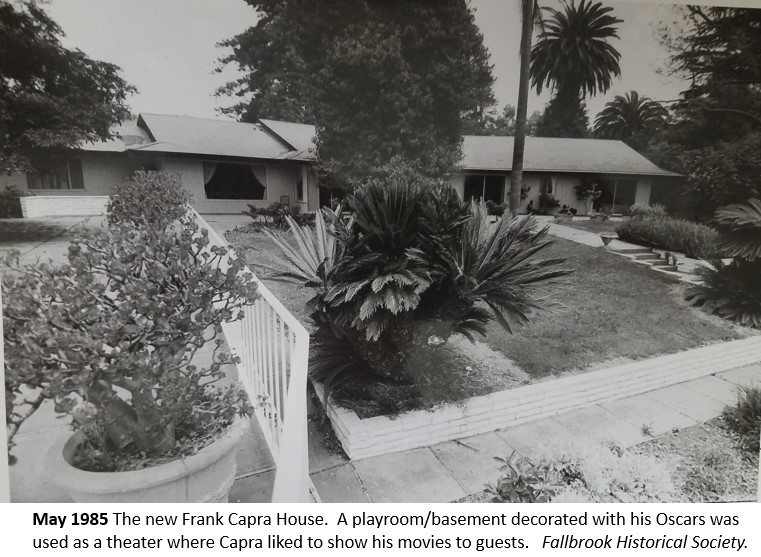
Epilogue: Capra made only a couple more feature films in Hollywood after 1959, A Hole in the Head with Frank Sinatra in 1959 and Pocketful of Miracles with Glen Ford in 1961.
By 1966, Frank Capra was fully retired. His wife of 52 years, Lucille, died in 1984. Frank’s health declined soon after her passing and he spent his final years in a condominium near La Quinta, Calif. Frank Capra passed away in September 3, 1991 at the age of 94. He is buried next to Lucille in Coachella Valley.
The lawsuit between FPUD and the federal government was finally settled to everyone’s satisfaction in 2019, 70 years after Frank Capra found himself of the middle of Fallbrook’s epic fight.
Although the long fought over Willow Creek dam was never built, Capra’s old Red Mountain Reservoir now holds 440 million gallons of water.
It’s a Wonderful Life has been recognized by the American Film Institute as one of the 100 best American films ever made.
Tom Frew,
FHS Historian
Acknowledgements:
Frank Capra’s authorized biography The Catastrophe of Success by Joseph McBride, published by Simon & Schuster in 1991, was broadly used to document Frank Capra’s life, his family, and his achievements.
Serving Fallbrook, the First 100 Years of the Fallbrook Public Utility District History Book by Jeff Crider, published by FPUD 2023. FPUD’s authorized history is the best documentation of the 70-year lawsuit between Camp Pendleton and FPUD that Capra got caught up in.
Fallbrook Historical Society files on Red Mountain Ranch from 1887 to Capra’s time, including
donated photos and recollections from those who knew him.
